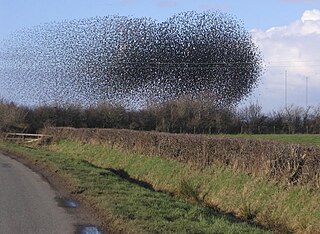Related Research Articles

In mathematics and physics, a soliton or solitary wave is a self-reinforcing wave packet that maintains its shape while it propagates at a constant velocity. Solitons are caused by a cancellation of nonlinear and dispersive effects in the medium. Solitons are the solutions of a widespread class of weakly nonlinear dispersive partial differential equations describing physical systems.

In physics, a plasmon is a quantum of plasma oscillation. Just as light consists of photons, the plasma oscillation consists of plasmons. The plasmon can be considered as a quasiparticle since it arises from the quantization of plasma oscillations, just like phonons are quantizations of mechanical vibrations. Thus, plasmons are collective oscillations of the free electron gas density. For example, at optical frequencies, plasmons can couple with a photon to create another quasiparticle called a plasmon polariton.

A granular material is a conglomeration of discrete solid, macroscopic particles characterized by a loss of energy whenever the particles interact. The constituents that compose granular material are large enough such that they are not subject to thermal motion fluctuations. Thus, the lower size limit for grains in granular material is about 1 μm. On the upper size limit, the physics of granular materials may be applied to ice floes where the individual grains are icebergs and to asteroid belts of the Solar System with individual grains being asteroids.

Granular convection is a phenomenon where granular material subjected to shaking or vibration will exhibit circulation patterns similar to types of fluid convection. It is sometimes described as the Brazil nut effect when the largest particles end up on the surface of a granular material containing a mixture of variously sized objects; this derives from the example of a typical container of mixed nuts, where the largest will be Brazil nuts. The phenomenon is also known as the muesli effect since it is seen in packets of breakfast cereal containing particles of different sizes but similar density, such as muesli mix.

In theoretical physics, the (one-dimensional) nonlinear Schrödinger equation (NLSE) is a nonlinear variation of the Schrödinger equation. It is a classical field equation whose principal applications are to the propagation of light in nonlinear optical fibers and planar waveguides and to Bose–Einstein condensates confined to highly anisotropic cigar-shaped traps, in the mean-field regime. Additionally, the equation appears in the studies of small-amplitude gravity waves on the surface of deep inviscid (zero-viscosity) water; the Langmuir waves in hot plasmas; the propagation of plane-diffracted wave beams in the focusing regions of the ionosphere; the propagation of Davydov's alpha-helix solitons, which are responsible for energy transport along molecular chains; and many others. More generally, the NLSE appears as one of universal equations that describe the evolution of slowly varying packets of quasi-monochromatic waves in weakly nonlinear media that have dispersion. Unlike the linear Schrödinger equation, the NLSE never describes the time evolution of a quantum state. The 1D NLSE is an example of an integrable model.
Washboarding or corrugation is the formation of periodic, transverse ripples in the surface of gravel and dirt roads. Washboarding occurs in dry, granular road material with repeated traffic, traveling at speeds above 8.0 kilometres per hour (5 mph). Washboarding creates an uncomfortable ride for the occupants of traversing vehicles and hazardous driving conditions for vehicles that travel too fast to maintain traction and control.
Harry L. Swinney is an American physicist noted for his contributions to the field of nonlinear dynamics.
A charge density wave (CDW) is an ordered quantum fluid of electrons in a linear chain compound or layered crystal. The electrons within a CDW form a standing wave pattern and sometimes collectively carry an electric current. The electrons in such a CDW, like those in a superconductor, can flow through a linear chain compound en masse, in a highly correlated fashion. Unlike a superconductor, however, the electric CDW current often flows in a jerky fashion, much like water dripping from a faucet due to its electrostatic properties. In a CDW, the combined effects of pinning and electrostatic interactions likely play critical roles in the CDW current's jerky behavior, as discussed in sections 4 & 5 below.
Dissipative solitons (DSs) are stable solitary localized structures that arise in nonlinear spatially extended dissipative systems due to mechanisms of self-organization. They can be considered as an extension of the classical soliton concept in conservative systems. An alternative terminology includes autosolitons, spots and pulses.
In a standard superconductor, described by a complex field fermionic condensate wave function, vortices carry quantized magnetic fields because the condensate wave function is invariant to increments of the phase by . There a winding of the phase by creates a vortex which carries one flux quantum. See quantum vortex.
Mitsutaka Fujita was a Japanese physicist. He proposed the edge state that is unique to graphene zigzag edges. Also, he theoretically pointed out the importance and peculiarity of nanoscale and edge shape effects in nanographene. The theoretical concept of graphene nanoribbons was introduced by him and his research group to study the nanoscale effect of graphene. He was an associate professor at Tsukuba University, and died of a subarachnoid hemorrhage on March 18, 1998. His posthumous name is Rikakuin-Shinju-Houkou-Koji (理覚院深珠放光居士) in Japanese.

A colloidal crystal is an ordered array of colloid particles and fine grained materials analogous to a standard crystal whose repeating subunits are atoms or molecules. A natural example of this phenomenon can be found in the gem opal, where spheres of silica assume a close-packed locally periodic structure under moderate compression. Bulk properties of a colloidal crystal depend on composition, particle size, packing arrangement, and degree of regularity. Applications include photonics, materials processing, and the study of self-assembly and phase transitions.
In physical optics or wave optics, a vector soliton is a solitary wave with multiple components coupled together that maintains its shape during propagation. Ordinary solitons maintain their shape but have effectively only one (scalar) polarization component, while vector solitons have two distinct polarization components. Among all the types of solitons, optical vector solitons draw the most attention due to their wide range of applications, particularly in generating ultrafast pulses and light control technology. Optical vector solitons can be classified into temporal vector solitons and spatial vector solitons. During the propagation of both temporal solitons and spatial solitons, despite being in a medium with birefringence, the orthogonal polarizations can copropagate as one unit without splitting due to the strong cross-phase modulation and coherent energy exchange between the two polarizations of the vector soliton which may induce intensity differences between these two polarizations. Thus vector solitons are no longer linearly polarized but rather elliptically polarized.

A trojan wave packet is a wave packet that is nonstationary and nonspreading. It is part of an artificially created system that consists of a nucleus and one or more electron wave packets, and that is highly excited under a continuous electromagnetic field.

Active matter is matter composed of large numbers of active "agents", each of which consumes energy in order to move or to exert mechanical forces. Such systems are intrinsically out of thermal equilibrium. Unlike thermal systems relaxing towards equilibrium and systems with boundary conditions imposing steady currents, active matter systems break time reversal symmetry because energy is being continually dissipated by the individual constituents. Most examples of active matter are biological in origin and span all the scales of the living, from bacteria and self-organising bio-polymers such as microtubules and actin, to schools of fish and flocks of birds. However, a great deal of current experimental work is devoted to synthetic systems such as artificial self-propelled particles. Active matter is a relatively new material classification in soft matter: the most extensively studied model, the Vicsek model, dates from 1995.
Fuzzy cold dark matter is a hypothetical form of cold dark matter proposed to solve the cuspy halo problem. It would consist of extremely light scalar particles with masses on the order of eV; so a Compton wavelength on the order of 1 light year. Fuzzy cold dark matter halos in dwarf galaxies would manifest wave behavior on astrophysical scales, and the cusps would be avoided through the Heisenberg uncertainty principle. The wave behavior leads to interference patterns, spherical soliton cores in dark matter halo centers, and cylindrical soliton-like cores in dark matter cosmic web filaments.

The hydrodynamic quantum analogs refer to experimentally observed phenomena involving bouncing fluid droplets over a vibrating fluid bath that behave analogously to several quantum mechanical systems.
Ramamurti Rajaraman is an Emeritus Professor of Theoretical Physics at the School of Physical Sciences at Jawaharlal Nehru University. He was also the co-Chairman of the International Panel on Fissile Materials and a member of the Bulletin of the Atomic Scientists' Science and Security Board. He has taught and conducted research in physics at the Indian Institute of Science, the Institute for Advanced Study at Princeton, and as a visiting professor at Stanford, Harvard, MIT, and elsewhere. He received his doctorate in theoretical physics in 1963 from Cornell University. In addition to his physics publications, Rajaraman has written widely on topics including fissile material production in India and Pakistan and the radiological effects of nuclear weapon accidents.
The Kundu equation is a general form of integrable system that is gauge-equivalent to the mixed nonlinear Schrödinger equation. It was proposed by Anjan Kundu as
Alan Harold Luther is an American physicist, specializing in condensed matter physics.
References
- E. Clément; L. Vanel; J. Rajchenbach; J. Duran (1996). "Pattern formation in a vibrated granular layer". Physical Review E. 53 (3): 2972–2975. Bibcode:1996PhRvE..53.2972C. doi:10.1103/PhysRevE.53.2972. PMID 9964589.
- Paul B. Umbanhowar, Francisco Melo & Harry L. Swinney (1996). "Localized excitations in a vertically vibrated granular layer". Nature. 382 (29 August 1996): 793–796. Bibcode:1996Natur.382..793U. doi:10.1038/382793a0. S2CID 4338010.
- O. Lioubashevski; Y. Hamiel; A. Agnon; Z. Reches & J. Fineberg (1999). "Oscillons and Propagating Solitary Waves in a Vertically Vibrated Colloidal Suspension". Physical Review Letters. 83 (16): 3190–3193. Bibcode:1999PhRvL..83.3190L. doi:10.1103/PhysRevLett.83.3190.
- H. Arbell & J. Fineberg (2000). "Temporally Harmonic Oscillons in Newtonian Fluids". Physical Review Letters. 85 (4): 756–759. Bibcode:2000PhRvL..85..756A. doi:10.1103/PhysRevLett.85.756. PMID 10991391.
- L. Stenflo & M. Y. Yu (1996). "Origin of oscillons". Nature. 384 (21 November 1996): 224. Bibcode:1996Natur.384..224S. doi: 10.1038/384224a0 .